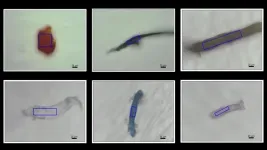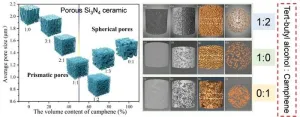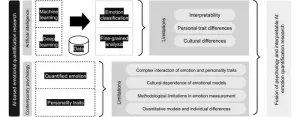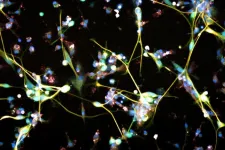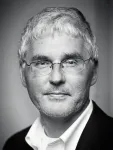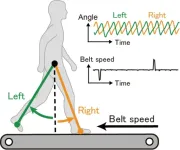(Press-News.org) Displaced individuals experience high rates of emotional distress, depression and anxiety resulting from trauma and stress from displacement and loss. Their mental health may suffer further due to a lack of resources, language barriers, and discrimination during resettlement.
A new study by University of California San Diego researchers reports that displaced Syrian refugees with higher reported self-compassion were less likely to report poor mental health outcomes. The study was published in PLOS ONE on September 19, 2024.
Sarah Alsamman, a student at UC San Diego School of Medicine, and Wael Al-Delaimy, M.D., Ph.D., professor of public health at the Herbert Wertheim School of Public Health and Human Longevity Science, along with local partners, surveyed 272 displaced Syrians residing in Amman, Jordan about their history of trauma and mental health symptoms. The participants were recruited through community organizations providing aid and educational opportunities to refugees.
“In spending time with these communities, I learned about the complex network of stressors they faced, including severe unemployment, limited access to health care, and separation from family,” said Alsamman.
The researchers also asked participants about their level of self-compassion. This could include practicing kindness and tenderness toward themselves when going through a difficult time instead of judging themselves harshly, engaging in non-judgmental mindfulness toward painful thoughts, and recognizing that they are not alone, but part of a larger human experience.
The participants also rated their perceived level of resilience in the face of adversity.
“Resilience reflects their belief in themselves, their community, their family tradition, or social support,” said Al-Delaimy.
Key findings of the survey data revealed:
More than 75 percent of the refugees experienced anxiety, emotional distress or depression.
Respondents reporting higher levels of self-compassion experienced more than 80% lower symptoms of depression and anxiety.
While self-compassion and resilience may interact with each other to protect mental health, self-compassion plays a more powerful role in mitigating mental health.
Previous studies have documented the capacity of resilience to limit mental health stressors experienced by refugees, but this is the first time self-compassion has been shown to potentially moderate mental illness in this population.
Al-Delaimy says unlike resilience, self-compassion is a self-taught, modifiable practice that can be increased through training, and thinks health care professionals could use this to promote positive mental health outcomes among refugees who typically have limited access to mental health care.
“This could become an innovative way to empower displaced communities processing an incredibly unjust life experience. Our goal is to shift to a strength-based approach aimed at identifying and cultivating factors that protect from negative mental health outcomes,” said Al-Delaimy.
Syrian refugees account for more than one-third of all displaced persons around the globe, with over 14 million forced to flee their homes during more than a decade of ongoing conflict. The researchers plan to extend their study by testing the impact of self-compassion interventions on mental health in a larger group of displaced Syrians living in Southern California.
“That's another aspect that we are trying to address: Is there a difference among those who are outside the country and people who have been resettled here?” Al-Delaimy said.
Rana Dajani of The Hashemite University in Jordan and the MIT Refugee Action Hub (ReACT) co-authored the study.
The T. Denny Sanford Institute for Empathy and Compassion at UC San Diego provided support for the first author, Sarah Alsamman.
# # #
END
Self-compassion is related to better mental health among Syrian refugees
Teaching self-compassion could be an efficient intervention in the future to boost the mental health of displaced individuals with limited access to health care.
2024-09-20
ELSE PRESS RELEASES FROM THIS DATE:
Microplastics found in coral skeletons
2024-09-20
Fukuoka, Japan—Researchers from Japan and Thailand investigating microplastics in coral have found that all three parts of the coral anatomy—surface mucus, tissue, and skeleton—contain microplastics. The findings were made possible thanks to a new microplastic detection technique developed by the team and applied to coral for the first time.
These findings may also explain the ‘missing plastic problem’ that has puzzled scientists, where about 70% of the plastic litter that has entered the oceans cannot be found. The team hypothesizes ...
Stroke rates increasing in individuals living with SCD despite treatment guidelines
2024-09-20
(WASHINGTON, September 20, 2024) –The incidence of stroke continues to increase for adults and children living with sickle cell disease (SCD) despite the Stroke Prevention Trial in Sickle Cell Anemia (STOP) establishing standards of care like transfusions and tests to measure blood flow in the brain for those deemed high-risk, according to a study published today in Blood.
Individuals living with SCD, the most common inherited red blood cell disorder in the United States, are especially susceptible to cerebrovascular events (CVEs). This includes ischemic or hemorrhagic strokes, when a blood vessel leading to the brain is ...
Synergistic promotion of dielectric and thermomechanical properties of porous Si3N4 ceramics by a dual-solvent template method
2024-09-20
Radomes and wave-transmitting antenna windows are critical structural components in aircraft, protecting radar antennas from external interference while ensuring reliable communication. Currently, the most widely used wave-transmitting materials are ceramics based on oxides and nitrides. Si3N4 ceramics, with their high melting point and superior mechanical properties, are considered promising candidates for hypersonic vehicle applications. However, the dielectric and thermal insulation properties of dense Si3N4 ceramics need improvement to meet the precise guidance and thermal protection demands of high-speed flight. By adjusting the microstructure, it is possible to enhance the ...
Korean research team proposes AI-powered approach to establishing a 'carbon-neutral energy city’
2024-09-20
A joint research team from the Renewable Energy System Laboratory and the Energy ICT Research Department at the Korea Institute of Energy Research (KIER) has developed key technologies to realize "Urban Electrification" using artificial intelligence (AI).
Urban electrification aims to reduce the use of fossil fuels and introduce renewable energy sources, such as building-integrated solar technology, to transform urban energy systems. While this concept is relatively unfamiliar in the Republic of Korea, it is being promoted as a key strategy in the U.S. and Europe for achieving carbon neutrality and creating sustainable urban environments.
In ...
AI is learning to read your emotions, and here’s why that can be a good thing
2024-09-20
Using a fusion of traditional and novel technological methods, researchers are hoping to better quantify emotions to transform the face of the emotion quantification field
Human emotions are complex and are not always easily able to be boiled down to a recognizable pattern. Determining one’s emotional state can be difficult human-to-human, and the many nuances of existence as an emotional entity seem impossible to train a non-human entity to understand, identify and learn from. However, a considerable amount of work and research has been put into training artificial intelligence (AI) to observe, quantify and recognize various states of emotion in humans. ...
Antidepressant shows promise for treating brain tumors
2024-09-20
Key points:
Glioblastoma is an incurable and fatal type of brain cancer.
In a large-scale drug screening, the antidepressant, vortioxetine emerged as one of the most effective agents against these types of cancer cells.
Clinical trials are already in the planning phase at the University Hospital Zurich.
Glioblastoma is a particularly aggressive brain tumour that at present is incurable. Cancer doctors can extend patients’ life expectancy through operations, radiation, chemotherapy or surgical interventions. Nevertheless, half of patients die within twelve months of diagnosis.
Drugs that are effective against brain tumours are ...
European Green Deal: a double-edged sword for global emissions
2024-09-20
The European Union aims to be carbon-neutral by 2050 as part of the comprehensive Green Deal that was agreed upon four years ago. However, an analysis of the policy documents outlining the practical measures of the Green Deal shows that it will decrease carbon emissions in Europe, but also increase carbon emissions outside of the EU. This increase is more than double the amount of carbon emissions saved by the Green Deal. This analysis was published in Nature Sustainability on <DATE> by an international team of scientists led by Klaus Hubacek, Professor of Science, Technology and Society ...
Walking in lockstep
2024-09-20
Osaka, Japan – Walking is an activity that is often taken for granted. Most people usually think they can multitask by “walking and chewing gum” simultaneously with hardly any taxation of their mental effort. Indeed, each leg can move rhythmically independently of the other, controlled by its side of the spinal cord. However, the ability of the human brain to coordinate the gait so that a walker’s legs are half a stride out of phase with each other, called the “antiphase relationship,” is not so trivial when an obstacle or asymmetry occurs, such as a curve in the path. A better understanding of how a normal walking cadence is maintained ...
New blood test could be an early warning for child diabetes
2024-09-20
A new type of blood test using lipids could make it easier to identify children at risk of complications around obesity including type two diabetes, liver and heart disease, say scientists.
A new study from King’s College London published in Nature Medicine reveals a new relationship between lipids and diseases impacting metabolism in children, which could serve as an early warning system for conditions like liver disease.
Using machines that test blood plasma in babies that already exist in hospitals, the researchers suggest this ...
Oceanic life found to be thriving thanks to Saharan dust blown from thousands of kilometers away
2024-09-20
Iron is a micronutrient indispensable for life, enabling processes such as respiration, photosynthesis, and DNA synthesis. Iron availability is often a limiting resource in today’s oceans, which means that increasing the flow of iron into them can increase the amount of carbon fixed by phytoplankton, with consequences for the global climate.
Iron ends up in oceans and terrestrial ecosystems through rivers, melting glaciers, hydrothermal activity, and especially wind. But not all its chemical forms are ‘bioreactive’, that is, available for organisms ...
LAST 30 PRESS RELEASES:
Short-circuiting pancreatic cancer
Groundbreaking mapping: how many ghost particles all the Milky Way’s stars send towards Earth
JBNU researchers propose hierarchical porous copper nanosheet-based triboelectric nanogenerators
A high-protein diet can defeat cholera infection
A more accurate way of calculating the value of a healthy year of life
What causes some people’s gut microbes to produce high alcohol levels?
Global study reveals widespread burning of plastic for heating and cooking
MIT study shows pills that communicate from the stomach could improve medication adherence
Searching for the centromere: diversity in pathways key for cell division
Behind nature’s blueprints
Researchers search for why some people’s gut microbes produce high alcohol levels
Researchers find promising new way to boost the immune response to cancer
Coffee as a staining agent substitute in electron microscopy
Revealing the diversity of olfactory receptors in hagfish and its implications for early vertebrate evolution
Development of an ultrasonic sensor capable of cuffless, non-invasive blood pressure measurement
Longer treatment with medications for opioid use disorder is associated with greater probability of survival
Strategy over morality can help conservation campaigns reduce ivory demand, research shows
Rising temperatures reshape microbial carbon cycling during animal carcass decomposition in water
Achieving ultra-low-power explosive jumps via locust bio-hybrid muscle actuators
Plant-derived phenolic acids revive the power of tetracycline against drug-resistant bacteria
Cooperation: A costly affair in bacterial social behaviour?
Viruses in wastewater: Silent drivers of pollution removal and antibiotic resistance
Sub-iethal water disinfection may accelerate the spread of antibiotic resistance
Three in four new Australian moms struggle with body image
Post-stroke injection protects the brain in preclinical study
Cardiovascular risk score predicts multiple eye diseases
Health: estimated one in ten British adults used or interested in GLP-1 medications for weight loss
Exercise to treat depression yields similar results to therapy
Whooping cough vaccination for pregnant women strengthens babies’ immune system
Dramatic decline in new cases of orphanhood in Uganda driven by HIV treatment and prevention programs
[Press-News.org] Self-compassion is related to better mental health among Syrian refugeesTeaching self-compassion could be an efficient intervention in the future to boost the mental health of displaced individuals with limited access to health care.

